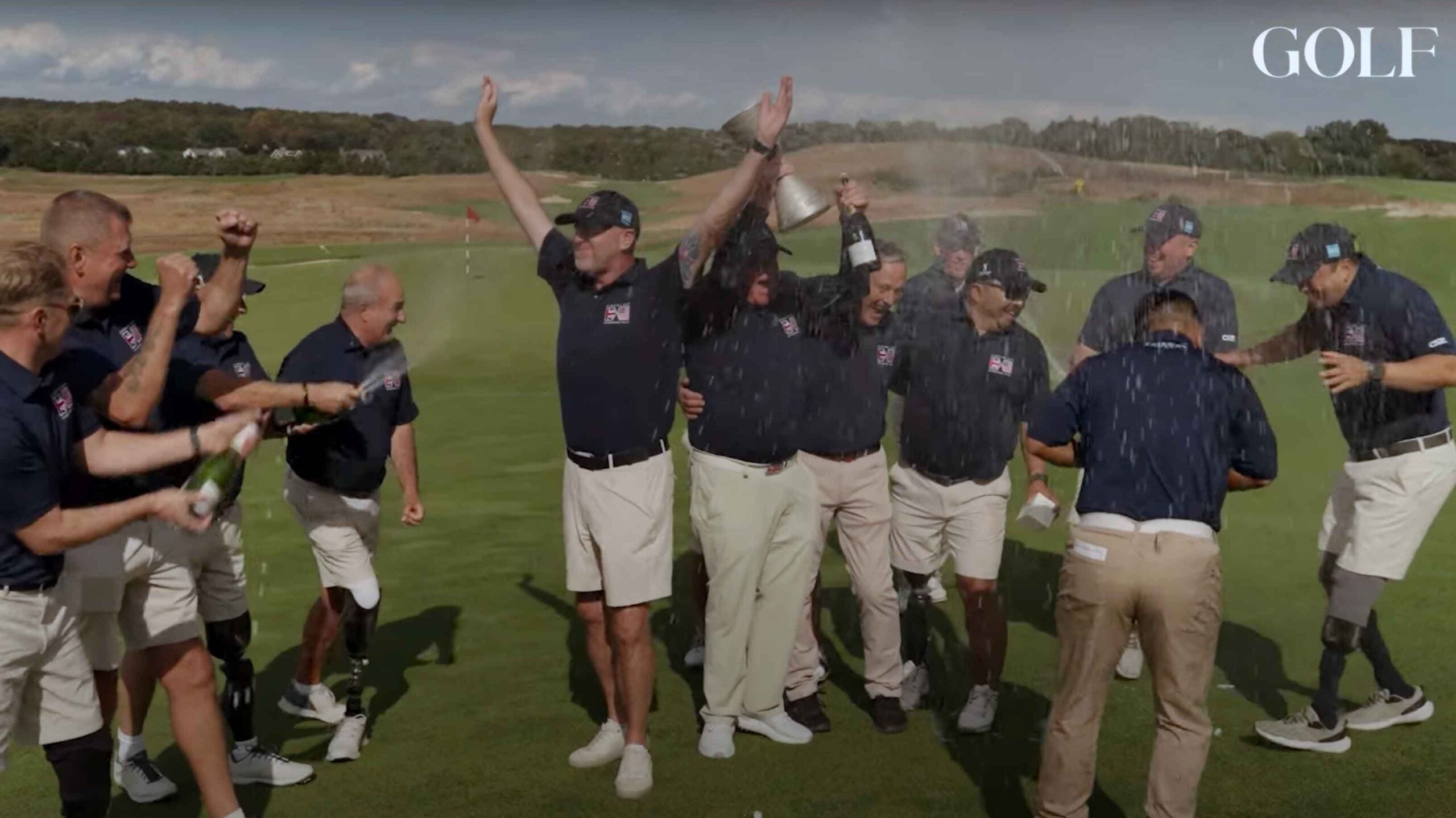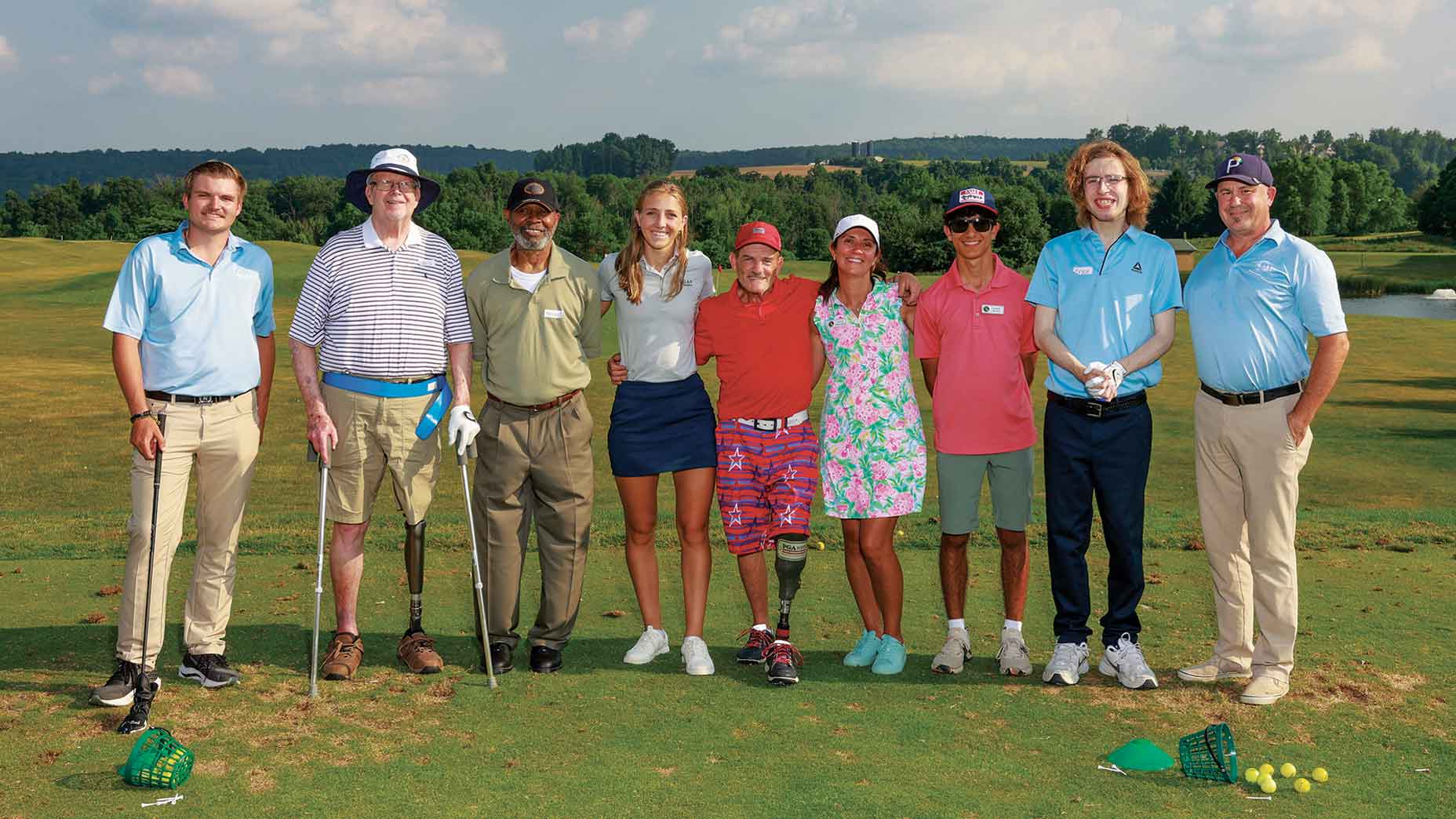 WATCH: Wounded veterans compete, inspire in Shinnecock Hills event
WATCH: Wounded veterans compete, inspire in Shinnecock Hills event
As you like it: How an army of Instagrammers is putting a smartphone spin on the game’s oldest virtues
In the spring of 2011, with classes winding down at Rollins College, in Winter Park, Florida, Ian Gilley, a four-year letterman on the golf team, was grappling with a downside of growing up. Graduation meant that he and his two roommates, who were also teammates, would soon be parting ways, dispersed around the country into young adulthood.
The three were kindred spirits, competitive golfers whose love for the game lay beyond the competition. One of their favorite courses was Sugarloaf Mountain, an un-Florida-like design that sat an easy drive from the Rollins campus. Affordable and walking-friendly, rich in character and quirk, it was their go-to spot for casual rounds, the embodiment of everything they thought that golf should be. That this fellowship was ending left Gilley feeling wistful. Keen to stay connected in post-collegiate life, he created a private Facebook page where he and his buddies could revel in golf geekdom. They could dweeb out on design, talk smack and plan trips, deliver disquisitions on must-see sleeper layouts.
Gilley called the forum the Sugarloaf Social Club.
“It was really just intended to be a kind of umbrella over our friend-group of golf nerds,” Gilley says. “We thought that maybe it could expand, as we all made new friends in new places. But the basic idea was just to encourage us to carry on.”
By late summer, as his roommates settled into jobs in other cities, Gilley landed in Washington D.C., interning for a congressman on Capitol Hill. On a modest budget and without a car, he took to playing the local muni circuit and fell in with a gaggle of like-minded golfers, including a newbie to the game named Harrison Lewis, who also happened to be Gilley’s boss. Lewis soon became a Sugarloafer, a member of the private Facebook club.
Around this time, a new photo-sharing app called Instagram was gaining traction. Gilley recognized it as a dream pairing for golf: a visual platform, ready-made for an eye-candy sport. You could spotlight where you’d been and where you’d played, even the gear you’d picked up along the way. The content had the makings of stuff that golfers loved — like a coffee table book, or a glossy magazine — except that you could stash it in your pocket and anyone could look at it from anywhere.

Establishing a Sugarloaf Social Club account, Gilley posted his first photos. His smartphone was an archive of nifty golf pics, some snapped at primo layouts he’d played in college, others taken at scruffy spots in Scotland, where Gilley had spent a semester abroad. A handful of followers soon found him, then multiplied the way that followers do, swelling to several hundred, then 1,000, then 5,000 and beyond. Gilley was struck not only by the numbers but also by the heartfelt feedback. He’d tapped into something.
To his mind, he wasn’t just dispatching images into the ether. “It felt like I was sending out a Bat signal to golf nerds everywhere,” Gilley says.
Scroll to the present. The original Sugarloaf Facebook group remains alive and well, capped at a couple dozen friends, as does the Sugarloaf Instagram account. But today the name applies to something more. With Gilley and Lewis as co-conspirators, the Sugarloaf Social Club has become a full-time business, a boutique apparel company that doubles as a branding agency (operating as the Sugarloaf Creative Lab), its projects ranging from collaborative product launches with clothing labels to consulting gigs with such towering institutions as Augusta National Golf Club and Pinehurst Resort.
https://www.instagram.com/p/BpDJ7_cHgod/
In its evolution and its impact, Sugarloaf represents a crossover success. It also stands at the vanguard of a movement with increasing relevance in golf circles, one that’s influencing the fate of courses, redirecting trends in gear and apparel, and reframing conversations about the game itself. What to call this movement is an open question. Gilley describes it loosely as a “neo-renaissance,” and as the term suggests, the ideas that drive it aren’t new. They combine the spiritual seeking of Shivas Irons with the design-connoisseurship of Golf Club Atlas and the irreverent populism of Happy Gilmore, all wrapped in fashion leanings that nod to Arnold Palmer and Bobby Jones. At the core of the ethos is a throwback sensibility, prettied up and packaged for the modern day.
The movement finds expression in many forms. You can detect its currents in the sepia-toned pages of The Golfer’s Journal and in the plucky podcasts of No Laying Up. You can read it in the architectural musings of Andy Johnson, founder of the online platform “The Fried Egg,” and see it in the videos of Erik Anders Lang, a Los Angeles film producer-turned-golf adventurer and proselytizer for not keeping score. Many in the movement are outside-the-establishment figures with a growing foothold in it. A rare few are mainstreamers with Everyman appeal. Zac Blair, a Tour pro largely unknown to the average Tour fan, is idol to legions on social media, who can’t wait to click and find out what he’s up to next. (Hint: One of the things he is up to is raising funds to build a public course in his home state of Utah.)
Most prominent, perhaps, in this wide-angle picture are the eclectic profiles of a zillion Instagrammers, competing for eyeballs in a packed golf space. There are art house–style photographers drawn to the Golden Age of golf course architecture; edgy shooters with a punk aesthetic; and iPhone-wielding “influencers” shilling for products, destinations and themselves, some in more sexed-up outfits than others.
“Some people will tell you that platforms like Instagram place power in the hands of people who don’t deserve it,” says active Instagrammer Ashley Mayo, an 11-year veteran of Golf Digest and now editorial director at GOLF. “But storytelling—yes, visual storytelling—is storytelling, and the ones who do it best will rise to the top and stay there longer than anyone else.”
That clicks are the new coin of the realm doesn’t mean they always translate into cash. Nor, for many, is that the point. For every No Laying Up (a media company built off a Twitter feed that has earned the buy-in of such brands as Callaway and BMW), there are countless golf enthusiasts in cyberspace who have never dreamed of drawing up a business plan.
https://www.instagram.com/p/B02L-VCHL6q/
Still others embrace posting as a side gig. Jon Cavalier is a New Jersey golf junkie who catalogs his golf life (above) under @linksgems but pays his bills as an attorney. Christian Hafer (@hafe_life), who has a full-time gig working at a supply chain for Fortune 500 companies, has parlayed his idiosyncratic point of view into, among other things, major-event assignments for this magazine and its digital platforms. Ben Peters (@thegolfhawk) is an accomplished amateur golfer who spends his workdays as a caddie at a private club in San Francisco and his free days peering through a camera lens at other courses. The pursuit has netted Peters paid work snapping pictures of products and courses, but he says the money isn’t his prime motivation.
“I just want to be involved,” Peters says. “If it’s ever lucrative in any way, that’s a huge bonus. But if not, that doesn’t change the fact that when I’m out there with my camera, the time flies by because it’s so much fun.”
The glitter may not be all about the gold. But there’s plenty of allure in the potential lifestyle perks (airfare covered, greens fees comped, red carpet rolled out at luxe resorts), along with the cachet of social media affirmation, a currency of highly subjective worth.
In this crowded landscape, it’s often hard to tell what moves the needle and what amounts to little more than an echo chamber of Millennials congratulating one another on their stylish outfits or their snazzy shots of Cypress Point. You don’t have to be an aging curmudgeon to regard some of the content as vacuous and smug.
Not surprisingly, for some members of golf’s old guard, golf’s youth movement can be a touchy subject. When reflecting on it, long-timers often sound like grouches yelling at some kids to get off their lawn.
This point came into relief two summers ago at the opening of Mammoth Dunes, the second 18-hole course at Sand Valley, in Wisconsin. At a cocktail party tied to the event, in a clubhouse restaurant crammed with industry players of all stripes, a veteran architecture writer gazed across the room at a thirtysomething blogger in a snug cotton shirt and the facial hair of a craft-mead maker. “Look at him,” the graybeard grumbled. “Just another access whore in hipper clothes!”
Let’s call that the jaded view.
* * * * *
A more generous take is that golf’s “neo-renaissance” arises from a hunger that the golf establishment has often failed to feed. Not everyone hankers for the latest swing tip or Tour pro gossip or Top 100 List of the Greatest Courses You’ll Probably Never Play. The most compelling Instagrammers serve up something else. Though they’re not the first to celebrate the joys of walking or to sing the praises of par-3 courses and lovely munis in need of TLC — all that stuff is older than Old Tom Morris — they’ve spread their messages on an easy-access platform and brought them to an audience of young consumers in an industry that needs all the young blood it can get.
“Some of what’s out there might take some of us out of our comfort zones,” says Tom Pashley, president of Pinehurst Resort. “But the bottom line is, there’s a lot we have to gain from it.”
The potential upsides were crystalized for Pashley in early 2018, when he received a message that some young guys were in town and that they’d love to meet him. They were Ian Gilley, Harrison Lewis and a small posse from the Sugarloaf crew.
ADVERTISEMENT
Then in his late forties, Pashley was guiding Pinehurst through an interesting time, striving to position the resort for the future without forsaking its rich past. Though the grounds were living history — no golf property in this country is more deeply steeped in lore — Pinehurst could ill-afford to remain trapped in amber. Pashley did his best to keep up on Instagram, and “Sugarloaf Social Club” rang vaguely familiar.
Now, as a refresher, he clicked on the account. The low-key aesthetic was to his liking. So was the hashtag #playorperish, which Gilley and Lewis had adopted as a slogan, borrowing a phrase from the early 20th-century architect Robert Hunter. Pashley could relate. If you truly loved the game, swinging a club was central to survival. He agreed to get together for a beer.
“So we all sit down and just like that we’re talking about Donald Ross and the nuances of design and the simple but crucial importance of just helping people have fun on the golf course,” Pashley says. “It was clear to me right away—these were young guys, from a different generation, but their golf souls were as aged as mine.”
Pinehurst had recently cut the ribbon on The Cradle, a rollicking par-3 course, and was getting set to unveil its updated No. 4 Course, renovated by the architect Gil Hanse. Pashley had a passing thought: Maybe he should hire the Sugarloaf guys to help with some rebranding. What sealed the deal for him was the moment, some days later, when Pashley checked on Instagram. Sugarloaf’s feed contained a photo of The Cradle and this observation: “It is quite possible that the hippest destination in golf today is one that is 123 years old.”
“They’d absolutely nailed it,” Pashley says. “They’d captured exactly what we were trying to do.”
https://www.instagram.com/p/Bfopb-WHrxj/
Signed on as consultants, Gilley and Lewis dug through the Pinehurst archives. Among the fun facts they unearthed was that way back when, each of Pinehurst’s courses had been associated with a specific color. Since orange was the color historically linked to the No. 4 Course, there was no doubt what the shade of the new logo should be. That was the big picture. On the granular level, rebranding applied to such nitty-gritties as redesigned scorecards, tee markers, yardage stakes and rakes (all catnip for Instagrammers). It also extended to limited-edition merchandise releases, a page taken from Sugarloaf’s own practice of small-batch sales of hats, belts and other gear. Though he can’t precisely quantify the impact, Pashley calls the Sugarloaf collaboration “a big success.”
It’s probably fair to say that no rebranding campaign was ever going to make or break a place like Pinehurst. The same is true of Augusta National, which this past spring enlisted Sugarloaf to consult on branding and digital content at The Masters (Augusta being Augusta, this is not something Gilley and Lewis are at liberty to discuss). But for many smaller players in the golf industry, modern messaging can be all the difference.
Consider, for instance, Sweetens Cove GC, a bootstrapping nine-hole layout in Chattanooga, Tennessee. The Sugarloaf guys were among the early celebrants of this winning design, which opened on a shoestring in a lonely location. So was Andy Johnson of The Fried Egg, who hailed Sweetens for its user-friendly entertainment value. What began as viral buzz has since given rise to a bustling business—an underdog transformed into a golf-world darling. According to Rob Collins, Sweetens’ co-owner and designer, “Without social media, we wouldn’t exist.”
Another of Sweetens’ boosters is Zac Blair. Twice in the past year, Blair has gathered some 60 friends and acquaintances at Sweetens for an event he calls The Ringer, an informal golf outing aimed at raising money and awareness for the Buck Club, the Utah course that Blair is trying to build. In a video of the inaugural Ringer, posted last fall on No Laying Up, the event has the air of good hit-and-giggle fun, with—natch!—hickory sticks given out as prizes.
That it also has the whiff of “Don’t you wish you’d been invited?” points to another gripe about the “neo-renaissance”: In bucking some of golf’s insular conventions, its practitioners have created their own exclusive culture. Maybe if you’re hip enough, they’ll let you in the club.
At Sugarloaf, Gilley and Lewis are sensitive to this. They know that there’s no upside in making someone feel that unless they’ve got a bucket hat and leather carry bag, they’re not cool enough to occupy a tee box, much less appear on your Instagram account. Their approach to golf is willfully inclusive: Come as you are, as long as you’re attuned to where you’re going.
In that sense, Gilley says, golf courses are like restaurants. “You can have a muni that’s like a food truck where you can wear flip-flops and get the best taco you’ve ever had,” he says. “But also there’s the fancier, white-tablecloth experience, and maybe there you should tuck in your shirt.”
Bottom line, he adds: “I want people to experience golf however they want to.”
* * * * *
A lot of the golf that Gilley and Lewis say that they’ve enjoyed the most hasn’t taken place on courses found on highfalutin rankings lists. They reside on a roster of “Hidden Gems,” which is posted, with a map, on the Sugarloaf website. Included on that list is The Schoolhouse Nine, a par-three course in the Shenandoah Valley of Virginia that charges $15 dollars for all-day weekday play (the price jumps to $25 on weekends). Designed by Mike McCartin, who started as a shaper for architect Tom Doak, the course sits beside a pub and, of all things, a pinball arcade, and has a wooden box for honor-system payments. Its pedigree comes through in its clever angles and its artful contours, among other design-geek traits.
On a recent dewy morning, some 90-minutes south of Washington D.C., Gilley and Lewis, who live a couple of hours apart, with Schoolhouse between them, pulled into the Schoolhouse parking lot and strolled to the first tee. Gilley, who is 30, is broad-shouldered with brown hair and a beard. Lewis, who is 35, has black hair, cafe-poet glasses and a Corey Pavin build. Both wore jeans and T-shirts, well within the strictures of the Schoolhouse dress code.
With a few waggles as a warm-up, they were off. A golden retriever was lolling by the first hole. A foursome of women was putting out on nine. Gilley and Lewis say that the greatest satisfaction of their work is when the virtual gives rise to the real. Now and then, they’ll drop a note on Instagram—hey, we’re headed out to play; please join us if you can. They also organize periodic outings where they get to meet their followers in the flesh. A down-the-road ambition both men harbor is to pull a Zac Blair and build their own course. The Sugarloaf Mountain site strikes them as a possibility (that course went under in 2012, a delayed victim of the economic downturn), but the logistics would be tricky. And anyway, they say, for now they’re more than happy to champion courses that everyone can play.
Moving briskly, Gilley and Lewis breezed through their Schoolhouse round in less than 40 minutes: lag putts and laughs, followed by an early lunch and lagers.
That evening, from home, Gilley hopped on Instagram and composed a post.
“Today at Schoolhouse Nine,” he wrote, alongside a montage of photos, “there were more ladies than gents, more pups than lefties and about an equal ratio of pinball machines to golf holes. There were purposeful wildflowers, long eyelashes surrounding the bunkers and an overqualified super who loves this place so much he came out of retirement just to care for it.”
By morning, he had nearly 1,000 “likes.”
To receive GOLF’s all-new newsletters, subscribe for free here.
ADVERTISEMENT








